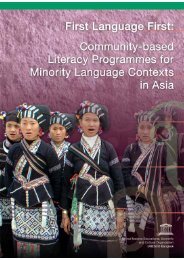Part II.pdf - MTB-MLE Network
Part II.pdf - MTB-MLE Network
Part II.pdf - MTB-MLE Network
You also want an ePaper? Increase the reach of your titles
YUMPU automatically turns print PDFs into web optimized ePapers that Google loves.
Linguistic Diversity in South-East Asia<br />
The sixth column of Table 1 provides figures for the total number of languages spoken in each<br />
South-East Asian country. Figure 2 displays the same data in a graphic format. The data shows<br />
that there are no monolingual nations in the region. In every country, at least 17 languages are<br />
spoken, as in Brunei. On the other hand, more than 700 languages are spoken in Indonesia, about<br />
200 in China, and 100-200 languages in Myanmar, Malaysia, and the Philippines.<br />
4. Regional Trends in the Use of Local Languages in Education<br />
General Situation in the Region<br />
This section sums up the trends regarding the use of local languages in basic education in<br />
South-East Asia and China. Earlier discussion explored the language issue in eleven countries. In<br />
most of these countries, local languages are used in education, but the extent varies significantly.<br />
China provides the most elaborate forms and widest range of models of education in local languages.<br />
Larger LWCs, as well as smaller local languages, are used at various levels of education – in some<br />
cases, up to the university level. However, not all minorities in China receive equal support, and<br />
many ethnolinguistic minorities in China are not any better off than most minority groups in<br />
South-East Asia.<br />
No country in South-East Asia has such elaborate systems as China for including local languages<br />
in education. Of all eleven nations discussed in this article, mother tongue-based bilingual education<br />
can actually be found only in China, although there are promising pilot projects in other countries,<br />
such as those in Cambodia. In Malaysia, mother tongue-based bilingual education is provided only<br />
in major languages such as Mandarin Chinese and Tamil. Generally, “bilingual education” in<br />
South-East Asia means education in the national language and English. Cases of this can be found<br />
in Brunei, the Philippines, Singapore, and to some extent, Malaysia. Oral use of local languages<br />
is fairly common in all countries. There is no documented evidence from all countries, but it can<br />
be assumed that if minority students do not understand the medium of instruction, and if the teacher<br />
and her/his students have another common language, that language is used for classroom interaction<br />
and explaining the subject matter. A recent study from Tanzania and South Africa found that, despite<br />
the official language policy, teachers and students use languages with which they are most comfortable<br />
(Brock-Utne & Holmarsdottir 2004).<br />
Benson (2003, 22) uses the concept of “foot-in-the-door” strategies, meaning “measures that can<br />
be taken to facilitate a gradual process of change in classroom languages and interaction.” Such<br />
strategies include the authorized use of oral mother tongue in classrooms, the use of the mother<br />
tongue in preschools, short-cut transitional bilingual education, the mother tongue as a school subject,<br />
and NFE and literacy programmes in the mother tongue. Further language development in minority<br />
languages and continuing participatory development of reading materials in local languages could<br />
be added to this list, as well. In most South-East Asian countries, some foot-in-the-door strategies<br />
are apparent. For instance, in Cambodia, Malaysia and Thailand, a gradual process towards potential<br />
mother tongue-based bilingual education is taking place. In these countries, as well as in other<br />
parts of the world, such a process has usually started with community and NGO efforts in adult<br />
115
















